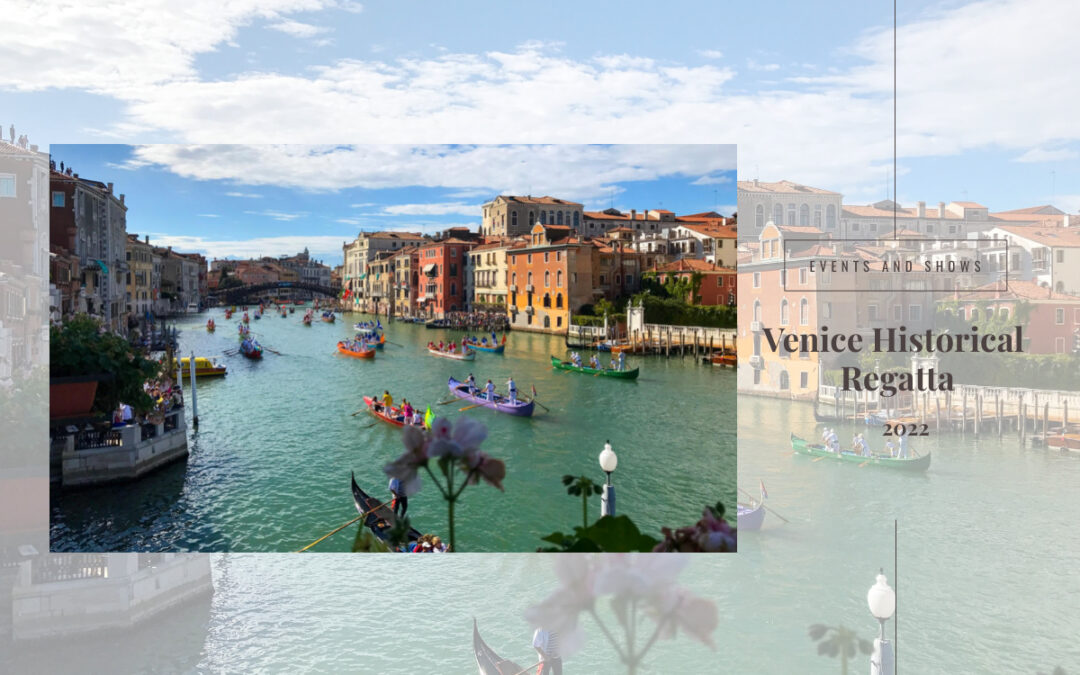Once again in 2022, the city of Venice is preparing for the Historical Regatta, which welcomes tourists from all over the world every year on the first Sunday in September.
What is it, when did it start and how does it take place?
A historical background
The history of the regatta is lost in the mists of time. We know that it has always been one of the most spectacular and exciting festivals in Venice, but the earliest evidence dates back to the 13th century and is linked to the Festa delle Marie.
On a graphic level, a view shows us small boats with Regatta of Venice written on the side, dated 1500. The term seems to derive from aurigare, meaning to compete, which was widely used in the 16th century.
We have information about modern regattas from 1841, when the organisational costs passed to the municipal administration. From 1866, when Venice became part of the Kingdom of Italy, the regattas became a way to remember the magnificence of the ancient Maritime Republic.
All that is known for certain is that it is a re-enactment dating back to 1489, when Venice welcomed Caterina Cornaro, wife of the King of Cyprus, who renounced her throne in favour of the city.
The regatta begins from Sant’Elena, typical 16th-century boats parade along the Grand Canal, the galley of the Doge and Dogaressa, called Bucintoro, is in the lead, with costumed gondoliers carrying the highest officials of the most famous and influential Maritime Republic in the Mediterranean; arriving at the Santa Lucia station, after which the real competition begins, in which millions of spectators take part every year, crowded along the banks or on the moored boats provided, all cheering for one boat over another.
The award ceremony takes place in front of Ca’ Foscari.
The milestones
One starts from the Paluo di Sant’Antonio (today Giardini di Sant’Elena) by cutting the spagheto, i.e. the string, while at the finishing station the winners cross the finish line, which is called paleto, i.e. a fixed pole in the waters of the Grand Canal opposite the Santa Lucia station.
The prizes are awarded on the machine, a floating building rich in carvings and gilded embellishments, resting on a raft in front of Ca’ Foscari.
The prizes consist of money and flags: the first place winner is given the red, the second the white, the third the green and the fourth the blue, this has to do with the colour of the gondolinos competing, which are repainted every year so that they never have the same colour.
The Historical Regatta 2022
This year’s Historical Regatta takes place on Sunday 4 September.
The events leading up to this event start on 26 August with the Disnar per la Storica, featuring entertainment and good food, followed by the Blessing of the gondolinos on Thursday 1 September at 6 pm, when the crews are introduced in a short procession along the waters of the Grand Canal.
Sunday, September 4th from 4 pm you can watch the historical procession and the competition, while at 4.30 pm, there is the Regatta of the Maciarele (small fish) and the Schie (the shrimps) dedicated to children and young people.
At 4.50 pm there is the Regatta of the youngest on Pupparini (small, elegant gondolas) with two oars, and at 5.10 pm the Caorline (long, thin fishing boats) with six oars. From 5.40 pm onwards the women take part in the regatta.
Useful information
Venice can be reached in many ways, by plane, train and car. The city is connected to the mainland at Mestre, where cars and trains can pass. The nearest railway station is Venezia Santa Lucia, the airports are Marco Polo or Treviso airport. It is also possible to arrive in Venice by ship from the cruise terminal.
We recommend, in any case, the Azienda di Trasporti Veneto Orientale bus line, a capillary network of buses that lead directly to the city from airports, railway stations and car parks along the coast. For information on purchasing tickets, routes and more, please visit the official website.
The desire is to experience unique moments in a magical city rich in tradition.




